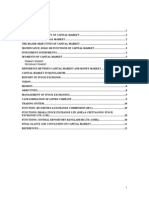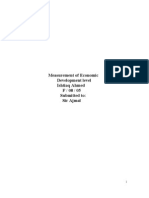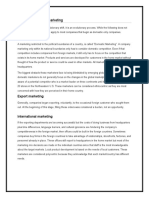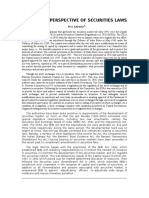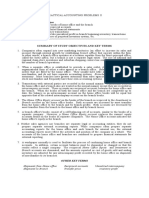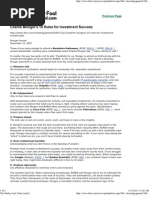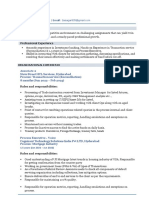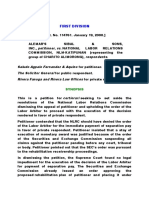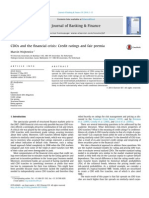Factors Affecting Exchange Rates
Factors Affecting Exchange Rates
Uploaded by
Anoopa NarayanCopyright:
Available Formats
Factors Affecting Exchange Rates
Factors Affecting Exchange Rates
Uploaded by
Anoopa NarayanCopyright
Available Formats
Share this document
Did you find this document useful?
Is this content inappropriate?
Copyright:
Available Formats
Factors Affecting Exchange Rates
Factors Affecting Exchange Rates
Uploaded by
Anoopa NarayanCopyright:
Available Formats
INTERNATIONAL FINANCE ASSIGNMENT
SUBMITTED BY, ANOOPA NARAYANAN S3 MBA (IB) ROLL NO.4 16/08/2011
INTRODUCTION
The foreign-exchange rate, forex rate or FX rate between two currencies is the rate at which one currency will be exchanged for another. It is also regarded as the value of one countrys currency in terms of another currency. For example, an interbank exchange rate of 91Japanese yen (JPY, ) to the United States dollar (US$) means that 91 will be exchanged for each US$1 or that US$1 will be exchanged for each 91. Exchange rates are determined in the foreign exchange market, which is open to a wide range of different types of buyers and sellers where currency trading is continuous: 24 hours a day except weekends, i.e. trading from 20:15 GMT on Sunday until 22:00 GMT Friday. The foreign exchange market (forex, FX, or currency market) is a global, worldwide decentralized financial market for trading currencies. Financial centers around the world function as anchors of trading between a wide range of different types of buyers and sellers around the clock, with the exception of weekends. The foreign exchange market determines the relative values of different currencies. The primary purpose of the foreign exchange is to assist international trade and investment, by allowing businesses to convert one currency to another currency. For example, it permits a US business to import British goods and pay Pound Sterling, even though the business' income is in US dollars. It also supports direct speculation in the value of currencies, and the carry trade, speculation on the change in interest rates in two currencies. All forex trading involves the exchange of one currency with another. At any one time, the actual exchange rate is determined by the supply and demand of the corresponding currencies. Keep in mind that the demand of a certain currency is directly linked to the supply of another. Likewise, when you supply a certain currency, it would mean that you have the demand for another currency. There are 2 exchange rates - spot exchange rate and forward exchange rate .The spot exchange rate refers to the current exchange rate. The forward exchange rate refers to an exchange rate that is quoted and traded today but for delivery and payment on a specific future date. In the retail currency exchange market, a different buying rate and selling rate will be quoted by money dealers. Most trades are to or from the local currency. The buying rate is the rate at which money dealers will buy foreign currency, and the selling rate is the rate at which they will sell the currency. Exchange rates play a vital role in a country's level of trade, which is critical to most every free market economy in the world. For this reason, exchange rates are among the most watched analyzed and governmentally manipulated economic measures. But exchange rates matter on a smaller scale as well: they impact the real return of an investor's portfolio. A higher currency makes a country's exports more expensive and imports cheaper in foreign markets; a lower currency makes a country's exports cheaper and its imports more expensive in foreign markets. A higher exchange rate can be expected to lower the country's balance of trade, while a lower exchange rate would increase it.
FACTORS INFLUENCING EXCHANGE RATES
Numerous factors determine exchange rates, and all are related to the trading relationship between two countries. Exchange rates are relative, and are expressed as a comparison of the currencies of two countries. The following are some of the principal determinants of the exchange rate between two countries. Economic factors These include: (a)Economic policy, disseminated by government agencies and central banks, (b)Economic conditions generally revealed through economic reports, and other economic indicators. Economic policy comprises government fiscal policy (budget/spending practices) and monetary policy (the means by which a government's central bank influences the supply and "cost" of money, which is reflected by the level of interest rates).
Monetary Policy When a central bank believes that intervention in the forex market is effective and the results would be consistent with the governments monetary policy; it will participate in forex trading and influence the exchange rates. A central bank generally participates by buying or selling the domestic currency so as to stabilize it at a level that it deems realistic and ideal. Judgment on the possible impact of governments monetary policy and prediction on future policy by other market players will affect the exchange rates as well.
Government budget deficits or surpluses: The market usually reacts negatively to widening government budget deficits, and positively to narrowing budget deficits. The impact is reflected in the value of a country's currency. Current-Account Deficits: The current account is the balance of trade between a country and its trading partners, reflecting all payments between countries for goods, services, interest and dividends. A deficit in the current account shows the country is spending more on foreign trade than it is earning, and that it is borrowing capital from foreign sources to make up the deficit. In other words, the country requires more foreign currency than it receives through sales of exports, and it supplies more of its own currency than foreigners demand for its products. The excess demand for foreign currency lowers the country's exchange rate until domestic goods and services are cheap enough for foreigners, and foreign assets are too expensive to generate sales for domestic interests.
Public Debt Countries will engage in large-scale deficit financing to pay for public sector projects and
governmental funding. While such activity stimulates the domestic economy, nations with large public deficits and debts are less attractive to foreign investors. A large debt encourages inflation, and if inflation is high, the debt will be serviced and ultimately paid off with cheaper real dollars in the future. In the worst case scenario, a government may print money to pay part of a large debt, but increasing the money supply inevitably causes inflation. Moreover, if a government is not able to service its deficit through domestic means (selling domestic bonds, increasing the money supply), then it must increase the supply of securities for sale to foreigners, thereby lowering their prices. Finally, a large debt may prove worrisome to foreigners if they believe the country risks defaulting on its obligations. Foreigners will be less willing to own securities denominated in that currency if the risk of default is great. For this reason, the country's debt rating (as determined by Moody's or Standard & Poor's, for example) is a crucial determinant of its exchange rate.
Balance of trade levels and trends: The trade flow between countries illustrates the demand for goods and services, which in turn indicates demand for a country's currency to conduct trade. Surpluses and deficits in trade of goods and services reflect the competitiveness of a nation's economy. For example, trade deficits may have a negative impact on a nation's currency. Trade balance also has an effect on a country's currency. If world prices for what a country exports rise in comparison with the cost of that country's imports, that country will be earning more for its exports than it pays for its imports. The more demand there will be for that country's currency, the better the deal becomes. If investors are confident that the US economy will be strong, they will be more likely to buy American assets, pushing up the dollar's value. If investors are not so confident that the economy will be strong, they will be less likely to buy the country's assets, pushing the dollar's value down.
Terms of Trade A ratio comparing export prices to import prices, the terms of trade is related to current accounts and the balance of payments. If the price of a country's exports rises by a greater rate than that of its imports, its terms of trade have favorably improved. Increasing terms of trade shows greater demand for the country's exports. This, in turn, results in rising revenues from exports, which provides increased demand for the country's currency (and an increase in the currency's value). If the price of exports rises by a smaller rate than that of its imports, the currency's value will decrease in relation to its trading partners.
Inflation levels and trends: Typically a currency will lose value if there is a high level of inflation in the country or if inflation levels are perceived to be rising. This is because inflation erodes purchasing power, thus demand, for that particular currency. However, a currency may sometimes strengthen when inflation rises
because of expectations that the central bank will raise short-term interest rates to combat rising inflation. As a general rule, a country with a consistently lower inflation rate exhibits a rising currency value, as its purchasing power increases relative to other currencies. During the last half of the twentieth century, the countries with low inflation included Japan, Germany and Switzerland, while the U.S. and Canada achieved low inflation only later. Those countries with higher inflation typically see depreciation in their currency in relation to the currencies of their trading partners. This is also usually accompanied by higher interest rates. Differentials in Interest Rates Interest rates, inflation and exchange rates are all highly correlated. By manipulating interest rates, central banks exert influence over both inflation and exchange rates, and changing interest rates impact inflation and currency values. Higher interest rates offer lenders in an economy a higher return relative to other countries. Therefore, higher interest rates attract foreign capital and cause the exchange rate to rise. The impact of higher interest rates is mitigated, however, if inflation in the country is much higher than in others, or if additional factors serve to drive the currency down. The opposite relationship exists for decreasing interest rates - that is, lower interest rates tend to decrease exchange ratesWhen a countrys key interest rate rises higher or falls lower than that of another country, the currency of the nation with lower interest rate will be sold and the other currency will be bought so as to achieve higher returns. Given this increase in demand for the currency with higher interest rate, the value of that currency will rise against other currencies. Let us use an example to illustrate how interest rates affect exchange rates. Assume there are two countries, A and B. Both countries do not exercise foreign exchange control and capital funds can flow freely between them. As part of its monetary policy, Country A raises its interest rate by 1% while the interest rate of Country B remains unchanged. There is a huge volume of liquid capital in the market that flows freely between these two countries, seeking out the best possible interest rate. With all other conditions remaining unchanged, as Country As key interest rate rises, a large portion of the liquid capital will flow into Country A. When the liquid capital flows out from Country B to Country A, a large amount of Country Bs currency will be sold in exchange for Country As currency. In this way, the demand for Country As currency will increase, strengthening i t against Country Bs currency. In fact, in todays globalized market, this scenario applies to the whole world. Over the years, the market trend has been shifting towards free capital mobility and elimination of foreign exchange restrictions. This enables liquid capitals (also known as hot money) to flow freely in the international market. A point to note though is that such capital will only be moved to a region or country with higher interest rate if their investors believe that the change in exchange rate will not nullify the returns gained with higher interest rate. If interest rates are higher in, say, the US than in other countries, then investors will choose to invest in the us, increasing demand for the dollar, provided that the expected rate of inflation is not higher in the us than among other trading partners. If interest rates are lower in the US than in other countries, investors will choose not to invest in the US, decreasing demand for the dollar. If the US
inflation rate is higher, investors are less likely to prefer the useven with higher interest rates because of the expectation that the value of the dollar will be eroded by inflation.
Economic growth and health Reports such as GDP, employment levels, retail sales, capacity utilization and others, detail the levels of a country's economic growth and health. Generally, the more healthy and robust a country's economy, the better its currency will perform, and the more demand for it there will be.
Productivity of an economy: Increasing productivity in an economy should positively influence the value of its currency. Its effects are more prominent if the increase is in the traded sector .
Political conditions Internal, regional, and international political conditions and events can have a profound effect on currency markets. All exchange rates are susceptible to political instability and anticipations about the new ruling party. Political upheaval and instability can have a negative impact on a nation's economy. For example, destabilization of coalition governments in Pakistan and Thailand can negatively affect the value of their currencies. Similarly, in a country experiencing financial difficulties, the rise of a political faction that is perceived to be fiscally responsible can have the opposite effect. Also, events in one country in a region may spur positive/negative interest in a neighboring country and, in the process, affect its currency. Foreign investors inevitably seek out stable countries with strong economic performance in which to invest their capital. A country with such positive attributes will draw investment funds away from other countries perceived to have more political and economic risk. Political turmoil, for example, can cause a loss of confidence in a currency and a movement of capital to the currencies of more stable countries. Growing global tension will result in instability in the forex market. Irregular inflow or outflow of currencies may result in significant fluctuations in exchange rates. The stability of a foreign currency is closely related to the political situation of that place. In general, the more stable the country is, the more stable its currency will be. We will illustrate how political factors influence exchange rates with some actual examples. At the end of 1987, the US Dollar was suffering from continuous depreciation. In order to stabilize the US Dollar, the G7 Finance Ministers and central bank governors released a joint statement on 23 December 1987 announcing plans for a large-scale intervention in the forex market. On 4 January 1988, the group started to dump Japanese Yen and Deutsche Mark in huge volumes while buying US Dollars. This resulted in a rebound of the US Dollar and maintained its exchange rate at a stable level. For our second example, if you have been observing the Euro, you would have noticed that for three consecutive months during the Kosovo War, the Euro fell by about 10% against the US Dollar. One of
the
reasons
was
the
downward
pressure
on
the
Euro
caused
by the
Kosovo
War.
Market psychology Market psychology and trader perceptions influence the foreign exchange market in a variety of ways:
Market Judgment The forex market does not always follow a logical pattern of change. Exchange rates are also influenced by intangible factors such as emotions, judgments as well as analysis and comprehension of political and economic events. Market operators must be able to interpret reports and data such as balance of payments, inflation indicators and economic growth rates accurately. In reality, before these reports and data become available to the public, the market would have already made its own predictions and judgments, and these will be reflected in the prices. In the event that the actual reports and data deviate too much from the predictions and judgments of the market, huge fluctuations in exchange rates will occur. Accurate interpretation of reports and data alone is not adequate, a good forex trader must also be able to determine market reactions before the information becomes publicly available.
Speculation Speculation by major market operators is another crucial factor that influences exchange rates. In the forex market, the proportion of transactions that are directly related to international trade activities is relatively low. Most of the transactions are actually speculative trading which cause currency movement and influence exchange rates. When the market predicts that a certain currency will rise in value, it may spark a buying frenzy that pushes the currency up and fulfill the prediction. Conversely, if the market expects a drop in value of a certain currency, people will start selling it away and the currency will depreciate. For example, after World War II, the United States enjoyed a period of political stability, well-managed economy, low inflation rate and an average annual economic growth of about 5% in the early 1960s. At that time, all the other countries in the world were willing to use US Dollar as the mode of payment to safeguard their wealth. This causes a continuous rise in value of the US Dollar. However, from the end of 1960s to early 1970s, the Vietnam War, Watergate scandal, serious inflation, increased tax burden, trade deficit and declining economic growth caused the US Dollar to plunge in value
Flights to quality Unsettling international events can lead to a "flight to quality", a type of capital flight whereby investors move their assets to a perceived "safe haven". There will be a greater demand, thus a higher price, for currencies perceived as stronger over their relatively weaker counterparts. The U.S. dollar, Swiss franc and gold have been traditional safe havens during times of political or economic uncertainty.
Long-term trends: Currency markets often move in visible long-term trends. Although currencies do not have an annual growing season like physical commodities, business cycles do make themselves felt. Cycle analysis looks at longer-term price trends that may rise from economic or political trends.
"Buy the rumor, sell the fact" This market truism can apply to many currency situations. It is the tendency for the price of a currency to reflect the impact of a particular action before it occurs and, when the anticipated event comes to pass, react in exactly the opposite direction. This may also be referred to as a market being "oversold" or "overbought". To buy the rumor or sell the fact can also be an example of the cognitive bias known as anchoring, when investors focus too much on the relevance of outside events to currency prices.
Economic numbers While economic numbers can certainly reflect economic policy, some reports and numbers take on a talisman-like effect: the number it becomes important to market psychology and may have an immediate impact on short-term market moves. "What to watch" can change over time. In recent years, for example, money supply, employment, trade balance figures and inflation numbers have all taken turns in the spotlight.
Conclusion
The exchange rate of the currency in which a portfolio holds the bulk of its investments determines that portfolio's real return. A declining exchange rate obviously decreases the purchasing power of income and capital gains derived from any returns. Moreover, the exchange rate influences other income factors such as interest rates, inflation and even capital gains from domestic securities. While exchange rates are determined by numerous complex factors that often leave even the most experienced economists flummoxed, investors should still have some understanding of how currency values and exchange rates play an important role in the rate of return on their investments.
References 1. Wikipedia,2009, Exchange rate, http://en.wikipedia.org/wiki/Exchange_rate downloaded on 15/09/2011 2. Top 5 Factors Affecting Exchange Rates, 2008, http://www.investopedia.com/articles/basics/04/050704.asp#ixzz1Xf5I9GBp downloaded on 15/09/2011
3. 6 Factors That Influence Exchange Rates ,2009, http://www.economywatch.com/exchange-rate/ downloaded on 16/09/2011 4. Factors influencing a country's exchange rate,2008, http://www.lavenant.com/free reports/Factors%20influencing%20a%20countrys%20exchange%20rate.pdf downloaded on 16/09/2011
You might also like
- Introduction To Forward Exchange Contracts and Their Relevance in Global BusinessDocument22 pagesIntroduction To Forward Exchange Contracts and Their Relevance in Global Businessakashsingh30898No ratings yet
- Determination of Exchange RateDocument14 pagesDetermination of Exchange RateAshish Tagade100% (2)
- Factors Influencing Exchange RatesDocument10 pagesFactors Influencing Exchange RatessudheerNo ratings yet
- Interest Rate Parity (IRP)Document13 pagesInterest Rate Parity (IRP)Hiron Rafi100% (1)
- Effect of Monetary Policy On Economic Growth in NigeriaDocument8 pagesEffect of Monetary Policy On Economic Growth in NigeriaEditor IJTSRDNo ratings yet
- Importance of Capital StructureDocument2 pagesImportance of Capital StructureShruti JoseNo ratings yet
- Forecasting Exchange Rates 1Document32 pagesForecasting Exchange Rates 1Afrianto Budi Aan100% (1)
- Difference Between Financial Management and International Financial ManagementDocument2 pagesDifference Between Financial Management and International Financial ManagementSitaKumariNo ratings yet
- Foreign Direct InvestmentDocument8 pagesForeign Direct InvestmentSneha LeeNo ratings yet
- Exchange Rate Management SystemsDocument3 pagesExchange Rate Management SystemsMonalisa PadhyNo ratings yet
- Meaning and Concept of Capital MarketDocument13 pagesMeaning and Concept of Capital MarketChowdhury Mahin AhmedNo ratings yet
- Global Marketing StrategiesDocument17 pagesGlobal Marketing StrategiesHunain Aziz100% (1)
- Chapter 7 Introduction To Portfolio ManagementDocument6 pagesChapter 7 Introduction To Portfolio Managementmoonaafreen0% (1)
- New Product DevelopmentDocument37 pagesNew Product DevelopmentAditya MaluNo ratings yet
- Sales Figure For The Fiscal Years Ended October 31 2014Document7 pagesSales Figure For The Fiscal Years Ended October 31 2014Tricky TratzNo ratings yet
- Trade and Services in Nepal: Opportunities and Challenges: Executive SummaryDocument4 pagesTrade and Services in Nepal: Opportunities and Challenges: Executive SummaryNeel GuptaNo ratings yet
- The Determinants of Exchange Rate in NigeriaDocument67 pagesThe Determinants of Exchange Rate in NigeriaRev. Kolawole, John ANo ratings yet
- Chapter - 2 (International Flow of Funds)Document23 pagesChapter - 2 (International Flow of Funds)shohag30121991100% (1)
- Comparative Financial StatementDocument25 pagesComparative Financial StatementharikrishnaNo ratings yet
- Importance of Balance of Payments For A CountryDocument1 pageImportance of Balance of Payments For A CountryYuki-Pauline NagatoNo ratings yet
- What Are The Six Key Differences Between Multinational and Domestic Financial Management?Document5 pagesWhat Are The Six Key Differences Between Multinational and Domestic Financial Management?susanta87100% (1)
- Effect of Dividend Policy On The Performance of Listed Oil and Gas Firms in NigeriaDocument14 pagesEffect of Dividend Policy On The Performance of Listed Oil and Gas Firms in NigeriaKolawole EbireNo ratings yet
- Exchange Rate Determination Chap 15Document32 pagesExchange Rate Determination Chap 15Munazza Jabeen50% (4)
- Business CycleDocument10 pagesBusiness CycleChetan KhaleNo ratings yet
- Equity Portfolio ManagementDocument22 pagesEquity Portfolio ManagementMayur DaveNo ratings yet
- Chapter Three Interest Rates in The Financial SystemDocument41 pagesChapter Three Interest Rates in The Financial SystemHamza AbduremanNo ratings yet
- 4 Government Influence On Exchange Rates PDFDocument26 pages4 Government Influence On Exchange Rates PDFshakil zibranNo ratings yet
- Exchange Rate RegimeDocument5 pagesExchange Rate RegimeNaman Dugar100% (1)
- Measurement of Economic DevelopmentDocument10 pagesMeasurement of Economic DevelopmentFaisal ShafiqueNo ratings yet
- Balance of PaymentDocument4 pagesBalance of PaymentMuazzam MughalNo ratings yet
- Segmenting Global MarketsDocument12 pagesSegmenting Global MarketsJenny YadvNo ratings yet
- International Financial ManagementDocument3 pagesInternational Financial ManagementSandeep Patil100% (3)
- Impact of Multiple EntrepriseDocument13 pagesImpact of Multiple EntrepriseMonika NarzaryNo ratings yet
- Forex Market in IndiaDocument24 pagesForex Market in IndiaHarshUpadhyayNo ratings yet
- Balance of Payment: According To International Monetary Fund (IMF)Document6 pagesBalance of Payment: According To International Monetary Fund (IMF)Asim RazaNo ratings yet
- Term Paper On Remittance and Its Impact On Nepalese Economy: Prof. Dr. Ram Prasad Gyanwaly MacroeconomicsDocument12 pagesTerm Paper On Remittance and Its Impact On Nepalese Economy: Prof. Dr. Ram Prasad Gyanwaly MacroeconomicsAshmita LamsalNo ratings yet
- FOREIGN EXCHANGE MARKET - Final ReportDocument33 pagesFOREIGN EXCHANGE MARKET - Final ReportDisha MathurNo ratings yet
- Impact of Electronic BankingDocument16 pagesImpact of Electronic BankingAbdulraheem Olalekan0% (1)
- InflationDocument41 pagesInflationMehul JainNo ratings yet
- International Finance - 1Document109 pagesInternational Finance - 1Mohamed Fathy100% (1)
- Role and Importance of Multinational Corporations in International BusinessDocument5 pagesRole and Importance of Multinational Corporations in International BusinessAdi ShahNo ratings yet
- Long Term Sources of FinanceDocument26 pagesLong Term Sources of FinancemustafakarimNo ratings yet
- Evolution To Global MarketingDocument6 pagesEvolution To Global Marketingmohittiwarimahi100% (2)
- Chapter 14-Multinational Capital BudgetingDocument29 pagesChapter 14-Multinational Capital BudgetingDeloar Hossain SagorNo ratings yet
- Effects of Interest Rate Fluctuation On The Economic Growth of GhanaDocument15 pagesEffects of Interest Rate Fluctuation On The Economic Growth of GhanaEmmanuel Ebo Arhin,Ch.FENo ratings yet
- Case 1 Is Coca-Cola A Perfect Business PDFDocument2 pagesCase 1 Is Coca-Cola A Perfect Business PDFJasmine Maala50% (2)
- Factors Affecting Interest RatesDocument1 pageFactors Affecting Interest RatesJasielle Leigh Ulangkaya100% (1)
- Global Portfolio ManagementDocument15 pagesGlobal Portfolio ManagementCheery Mea CostillasNo ratings yet
- Chapter 8 Secondary Data ResearchDocument23 pagesChapter 8 Secondary Data ResearchAmanda Samaras100% (1)
- Hospitality An Tourism Strategic PlanningDocument10 pagesHospitality An Tourism Strategic Planningaakanksha_rinniNo ratings yet
- The Euromarkets1Document22 pagesThe Euromarkets1Shruti AshokNo ratings yet
- What Is Price Skimming?: First MoverDocument9 pagesWhat Is Price Skimming?: First MoverDiya MukherjeeNo ratings yet
- 2023 - T - The Relationship Between Public Debt, Trade Openness, and Economic Growth in Indonesia Symmetric and Asymmetric AnalysisDocument26 pages2023 - T - The Relationship Between Public Debt, Trade Openness, and Economic Growth in Indonesia Symmetric and Asymmetric AnalysisNermeenNo ratings yet
- The Investment EnvironmentDocument31 pagesThe Investment EnvironmentsugandhirajanNo ratings yet
- TalalDocument7 pagesTalalUmer_Farooq_1557No ratings yet
- Factors Affecting Exchange RatesDocument2 pagesFactors Affecting Exchange Ratesanish-kc-8151No ratings yet
- Exchange Rates Foreign-Exchange Rate, Forex Rate or FX Rate)Document5 pagesExchange Rates Foreign-Exchange Rate, Forex Rate or FX Rate)SaadRasheedNo ratings yet
- 4.0 Setting ER & Factors Effecting ERDocument7 pages4.0 Setting ER & Factors Effecting ERMuhammad SeyamNo ratings yet
- FL Unit 2Document12 pagesFL Unit 2sabasehgal18No ratings yet
- Sample Business Plan - BlocketDocument29 pagesSample Business Plan - Blockettsion tehoneNo ratings yet
- Historical Perspective of Securities LawsDocument31 pagesHistorical Perspective of Securities LawsShivam KumarNo ratings yet
- Financial Analytics Jul Dec 24-1Document181 pagesFinancial Analytics Jul Dec 24-1Subroto DasNo ratings yet
- Airtel BillDocument10 pagesAirtel BillrajrishiiiNo ratings yet
- GPCSF12 0717Document50 pagesGPCSF12 0717Rivr RunnerNo ratings yet
- Mortgage Application Xpress (MAX) : ResidentialDocument12 pagesMortgage Application Xpress (MAX) : Residentialkai kaiNo ratings yet
- 2324 21 Si Og 0Document2 pages2324 21 Si Og 0easgoaNo ratings yet
- Dhirubhai Ambani 3748 PDFDocument6 pagesDhirubhai Ambani 3748 PDFVinayak ShettyNo ratings yet
- Meter Reading Billing Cash Collections and Credit Management For Electricity Supplies in NigeriaDocument10 pagesMeter Reading Billing Cash Collections and Credit Management For Electricity Supplies in Nigeriajoseph KogiNo ratings yet
- P230/1 Entrepreneurship Education Proposed Marking Guide Paper 1 Jul./Aug. 2012Document20 pagesP230/1 Entrepreneurship Education Proposed Marking Guide Paper 1 Jul./Aug. 2012kabuyeashirafkaluleNo ratings yet
- Pricing Guide For Wedding PhotographyDocument26 pagesPricing Guide For Wedding Photographyikipiki100% (1)
- Background Analysis - PDF - ENDocument1,086 pagesBackground Analysis - PDF - ENrox_dumitruNo ratings yet
- Taxation Comprehensive Exam TosDocument2 pagesTaxation Comprehensive Exam Tosaccounting probNo ratings yet
- 401 Chap13 Flashcards - QuizletDocument8 pages401 Chap13 Flashcards - QuizletJaceNo ratings yet
- CIR v. Tulio (Digest by Madz)Document3 pagesCIR v. Tulio (Digest by Madz)madzarellaNo ratings yet
- 0000A - Your Bar Attorney Is A FraudDocument38 pages0000A - Your Bar Attorney Is A Fraudsaffo40100% (8)
- Solman Government Accounting and Accounting For Non Profit Organizations 2018 Millan - CompressDocument68 pagesSolman Government Accounting and Accounting For Non Profit Organizations 2018 Millan - CompresshajymNo ratings yet
- Branches and Agencies - OdtDocument9 pagesBranches and Agencies - OdtEunice BernalNo ratings yet
- Journal of Entrepreneurship 1999 Kazmi 67 77Document12 pagesJournal of Entrepreneurship 1999 Kazmi 67 77Didie DbaNo ratings yet
- Companies (Incorporation) Regulations 2017 As Amended Upto April 17 2018Document26 pagesCompanies (Incorporation) Regulations 2017 As Amended Upto April 17 2018DudurNo ratings yet
- Charlie Munger 10 PrinciplesDocument2 pagesCharlie Munger 10 PrinciplesRohan Pinto100% (10)
- A Project Report On Financial Analysis of Co-Operative SocietyDocument48 pagesA Project Report On Financial Analysis of Co-Operative SocietyChittaranjanNo ratings yet
- Experienced ResumeDocument2 pagesExperienced ResumeHafsa NawaazNo ratings yet
- Eop ProfileDocument2 pagesEop Profileapi-459947404No ratings yet
- A Valuation Riddle Wrapped in A Mean Reversion Mystery Inside An Accounting EnigmaDocument26 pagesA Valuation Riddle Wrapped in A Mean Reversion Mystery Inside An Accounting EnigmaShivam NagpalNo ratings yet
- Depinder Singh Is A Friend of Yours Who Has WorkedDocument1 pageDepinder Singh Is A Friend of Yours Who Has WorkedBube KachevskaNo ratings yet
- Chapter 05Document7 pagesChapter 05hunny012kingNo ratings yet
- SALIHIN Malaysia Budget 2024 BulletinDocument25 pagesSALIHIN Malaysia Budget 2024 Bulletinhekate.yantraNo ratings yet
- Petitioner, vs. Respondents Saludo Agpalo Fernandez & Aquino The Solicitor General Rivera Fanoga and Rivera Law OfficesDocument8 pagesPetitioner, vs. Respondents Saludo Agpalo Fernandez & Aquino The Solicitor General Rivera Fanoga and Rivera Law OfficesLena BeeNo ratings yet
- Journal of Banking & Finance: Marcin WojtowiczDocument13 pagesJournal of Banking & Finance: Marcin Wojtowiczsohaib1234No ratings yet










